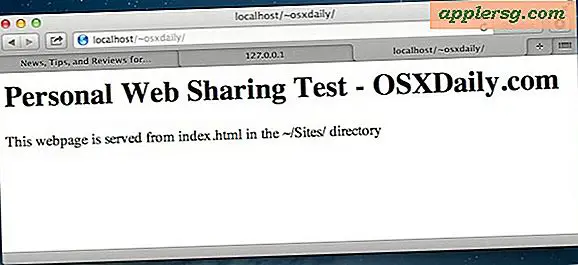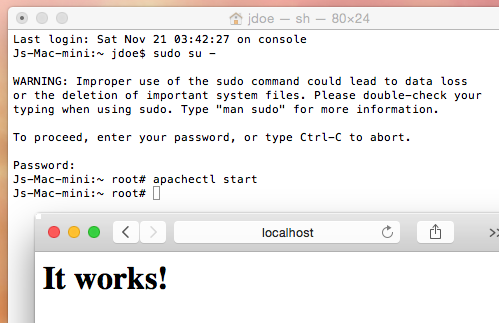macOS Update: While these instructions still work, there are new posts for recent versions of macOS, the latest being Install Apache, PHP, and MySQL on macOS Mojave.
I have installed Apache, PHP, and MySQL on Mac OS X since Leopard. Each time doing so by hand. Each version of Mac OS X having some minor difference. This post serves as much for my own record as to outline how to install Apache, MySQL, and PHP for a local development environment on Mac OS X Mountain Lion Mavericks.
I am aware of the several packages available, notably MAMP. These packages help get you started quickly. But they forego the learning experience and, as most developers report, eventually break. Personally, the choice to do it myself has proven invaluable.
It is important to remember Mac OS X runs atop UNIX. So all of these technologies install easily on Mac OS X. Furthermore, Apache and PHP are included by default. In the end, you only install MySQL then simply turn everything on.
The project is jointly managed by a group of volunteers located around the world, using the Internet and the Web to communicate, plan,. Httpd.conf is the Apache web server’s main configuration file. Mac OSX ships with Apache installed. See Apache’s configuration docs for how to configure Apache. Httpd.conf Location on Mac. On Mac httpd.conf location is in the directory /etc/apache2. You can access this folder through the Mac Finder or through the Mac Terminal.
First, open Terminal and switch to root to avoid permission issues while running these commands.
Enable Apache on Mac OS X
Note: Prior to Mountain Lion this was an option for Web Sharing in System Prefrences → Sharing.
Verify It works! by accessing http://localhost
Enable PHP for Apache
OS X Mavericks Update: You will need to rerun the steps in this section after upgrading an existing install to Mac OS X Mavericks.
First, make a backup of the default Apache configuration. This is good practice and serves as a comparison against future versions of Mac OS X.
Now edit the Apache configuration. Feel free to use TextEdit if you are not familiar with vi.
Uncomment the following line (remove #):

Restart Apache:
Install MySQL
- Download the MySQL DMG for Mac OS X
- Install MySQL
- Install Preference Pane
- Open System Preferences → MySQL
- Ensure the MySQL Server is running
- Optionally, you can enable MySQL to start automatically. I do.
The README also suggests creating aliases for mysql and mysqladmin. However there are other commands that are helpful such as mysqldump. Instead, I updated my path to include /usr/local/mysql/bin.
Note: You will need to open a new Terminal window or run the command above for your path to update.
I also run mysql_secure_installation. While this isn't necessary, it's good practice.
Connect PHP and MySQL

You need to ensure PHP and MySQL can communicate with one another. There are several options to do so. I do the following:
Creating VirtualHosts
You could stop here. PHP, MySQL, and Apache are all running. However, all of your sites would have URLs like http://localhost/somesite/ pointing to /Library/WebServer/Documents/somesite. Not ideal for a local development environment.
OS X Mavericks Update: You will need to rerun the steps below to uncomment the vhostInclude after upgrading an existing install to Mac OS X Mavericks.
To run sites individually you need to enable VirtualHosts. To do so, we'll edit the Apache Configuration again.
Uncomment the following line:
Now Apache will load httpd-vhosts.conf. Let's edit this file.
Here is an example of VirtualHosts I've created.
The first VirtualHost points to /Library/WebServer/Documents. The first VirtualHost is important as it behaves like the default Apache configuration and used when no others match.
The second VirtualHost points to my dev workspace and I can access it directly from http://jason.local. For ease of development, I also configured some custom logs.
Note: I use the extension local. This avoids conflicts with any real extensions and serves as a reminder I'm in my local environment.
Restart Apache:
In order to access http://jason.local, you need to edit your hosts file.
Add the following line to the bottom:

I run the following to clear the local DNS cache:
Now you can access http://jason.local.
Note: You will need to create a new VirtualHost and edit your hosts file each time you make a new local site.
A note about permissions
You may receive 403 Forbidden when you visit your local site. This is likely a permissions issue. Simply put, the Apache user (_www) needs to have access to read, and sometimes write, your web directory.
If you are not familiar with permissions, read more. For now though, the easiest thing to do is ensure your web directory has permissions of 755. You can change permissions with the command:
In my case, all my files were under my local ~/Documents directory. Which by default is only readable by me. So I had to change permissions for my web directory all the way up to ~/Documents to resolve the 403 Forbidden issue.
Note: There are many ways to solve permission issues. I have provided this as the easiest solution, not the best.
Install PHPMyAdmin
Unless you want to administer MySQL from the command line, I recommend installing PHPMyAdmin. I won't go into the details. Read the installation guide for more information. I install utility applications in the default directory. That way I can access them under, in this case, http://localhost/phpmyadmin.
Closing
Apache For Mac
A local development environment is a mandatory part of the Software Development Process. Given the ease at which you can install Apache, PHP, and MySQL on Mac OS X there really is no excuse.
Download Apache Web Server
Find this interesting? Let's continue the conversation on Twitter.
The Apache HTTP Server Project is an effort to develop and maintain anopen-source HTTP server for modern operating systems including UNIX andWindows. The goal of this project is to provide a secure, efficient andextensible server that provides HTTP services in sync with the current HTTPstandards.
The Apache HTTP Server ('httpd') was launched in 1995 and it has been the most popular web server on the Internet sinceApril 1996. It has celebrated its 25th birthday as a project in February 2020.
The Apache HTTP Server is a project of The Apache SoftwareFoundation.
The Apache Software Foundation and the Apache HTTP Server Project arepleased toannounce therelease of version 2.4.46 of the Apache HTTP Server ('httpd').
This latest release from the 2.4.x stable branch represents the best availableversion of Apache HTTP Server.
Apache HTTP Server version 2.4.43 or newer is required in order to operate a TLS 1.3 web server with OpenSSL 1.1.1.
Download | ChangeLog for2.4.46 | Complete ChangeLog for2.4 | New Features in httpd2.4
As previously announced, the Apache HTTP Server Project has discontinuedall development and patch review of the 2.2.x series of releases.
The Apache HTTP Server Project had long committed to provide maintenancereleases of the 2.2.x flavor through June of 2017. The final release 2.2.34was published in July 2017, and no further evaluation of bug reports orsecurity risks will be considered or published for 2.2.x releases.
Download Apache Web Server For Mac Os X
Great! We have updated our download page in an effort tobetter utilize our mirrors. We hope that by making it easier to use our mirrors, we will be able to provide a better download experience.
Mac Os Web Server
Please ensure that you verify your downloads usingPGP or MD5 signatures.
Awesome! Have a look at our current 'Help Wanted' listings then:
